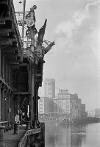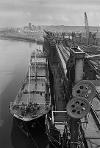Tyne Derwent Way at Dunston Staiths - a new home for art, heritage and nature activities


We love Dunston Staiths. There's no greater symbol of Gateshead's industrial heritage and it's a fantastic place to watch wildlife, go walking, breathe fresh air, watch the sunset... and it's right at the heart of the Tyne Derwent Way. So where better to have our new indoor space? It opens today!
A new indoor space by Dunston Staiths
Until the Staiths reopens for the spring and summer season, you can explore heritage, nature and culture here with us, on Staithes Road, Dunston, Gateshead NE11 9DR (https://w3w.co/jokes.spoil.waving).
It's the perfect base It's the perfect base for exploring Gateshead's green getaway, and our rich heritage and wildlife, and an ideal stopping-off point on your walk or bike ride along the Tyne Derwent Way. In one direction, explore Gateshead Riverside Park on your way up to St Mary's Heritage Centre; in the other, head towards the MetroCentre and the mouth of the River Derwent, then follow the valley up to Thornley Woodlands Centre, the Land of Oak and Iron, and Gibside.
We're open 3pm to 5pm on Thursdays and 10am to 2pm on Saturdays. Pop in and see us for a chat, a hot drink - or just to use the toilets.
Don't miss our incredible exhibition by Sirkka-Liisa Konttinen, a renowned Finnish photographer who's been recording the Tyneside and British landscapes since the 1960s. There's even a chance to meet the artist. Read on to find out more.
We hope to open up the space on other days for local community groups and organisations to use. Look out for more information about this soon.

Art activities twice a week
Also from today onwards, we have fun, free creative activities every Thursday and Saturday. Run by Dingy Butterflies, you can join a different artist every week and take part in art and craft that's suitable for people of all ages. Up first is Lottie Smith, helping you to make your own bird hat.
Heritage tours
Want to get a closer look at Dunston Staiths? Our guide, Tony Stephenson, will introduce you to this grand, Grade II listed timber structure and Scheduled Ancient Monument - thought to be the largest wooden structure in Europe.
The first free guided tour is on Saturday 1 February, starting at 11am. Please book as numbers are limited.
Nature at the Staiths
As one of our guides said on BBC1's The One Show, Dunston Staiths is "proper class for wildlife". Experience it for yourself on one of our morning birdwatching sessions, up on the top deck. The next one is on 6 February at 9am.
Coal Staiths of the Tyne - photographic exhibition
We're extremely fortunate to be hosting an amazing exhibition of photographs by Sirkka-Liisa Konttinen, and on 8 February you can meet the artist herself (it's free but please book). We'll be open at 10.30am, giving you half an hour to look round the exhibition before Sirkka-Liisa talks us through her experiences of photographing the Staiths as a young artist in the 1970s, while the Staiths were still actively transporting coal.
Here's Naz, our Heritage Officer, with some more information about Sirkka-Liisa and her work:
Sirkka-Liisa Konttinen is a Finnish photographer recording the Tyneside and British landscapes since 1960s. Her most famous works are an exhibition of Byker Revisited, the Dunston Staiths, Dance Schools in North Shields, Coalfield Stories and many more.
In the autumn of 1972, the Amber Associates decided to produce a body of work that used the River Tyne and its communities as a common theme. As a result of this scheme, different artists including painters, sculptures, photographers, writers and filmmakers were approached. Sirkka-Liisa Konttinen was one of the artists who took place in this project. Attracted to the North East for its industrial landscapes and communities during the early 1970s, and as a member of the Amber film and photography collective, Sirkka-Liisa started to photograph the coal at Dunston on the south bank of the River Tyne and at Whitehill Point on the north side.
Sirkka-Liisa says about her experience in this project:
"Coal arrived on the mineral railways that ran from nearby pits. At the end of the line men hopped on the wagons, riding on the sides to apply pressure to the brake levers. The wagons were tuned over to tip the coal out. As at Whitehill Point, or the coal dropped into the long shoots and then maneuvered by men with ropes into the waiting collier ships. The ships would take the millions of tons of coal around the British Isles and abroad."
She opens her memories of photographing the coal pits in Whitehall and Dunston Staiths with:
"I was granted unlimited access to all of its parts and levels. Un-chaperoned and without safety gear. I tried simply not to get carried away; I wouldn't have been the first person to disappear through the many coal holes into the clay bed beneath. The men didn't wear helmets or site safety gear either. The jackets, trousers and cloth caps they came to work in they went back home in, the coal dusted down.
"After the initial spell of bashfulness, the presence of a young lass in this all-male environment was met with gentlemanly courtesy and her language skills tested with Geordie humour."






